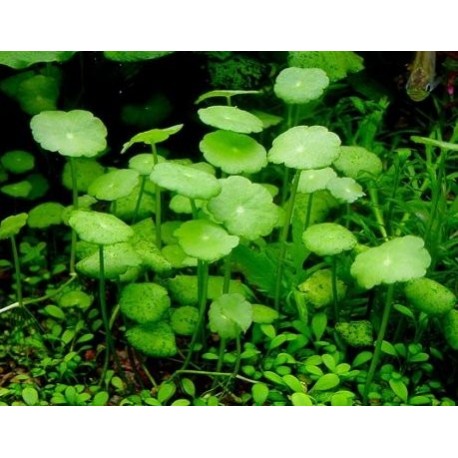Hydrocotyle verticilata retains its trailing growth form, unlike other Hydrocotyle species. Verticillata is native to America and grows to be 3-7 cm tall. Strong light and soft, slightly acidic water are required for optimal growth. It is not necessary to root it and can be used as a floating plant. Hydrocotyle verticillata is a foreground plant that is also appropriate for garden ponds. You can even use it as an indoor plant if the soil is kept moist.
The flowering hydrocotyle whorled pennywort is native to North and South America, as well as the West Indies. It is distinguished by its half-dollar-sized leaves, which can grow into dense green bushes. This plant is adaptable and can be used in both the foreground and background. It grows best when the leaves are kept dry. It is low-maintenance and grows quickly, frequently out-competing and outgrowing the tank if left untrimmed. The plant can stay low growing and create a carpeting effect over the foreground by frequently trimming new growth and using high light with CO2.
Trim stems and replant on pulling apart dense clumps and splitting the roots to propagate. Trimming new shoots anywhere along the stem allows the plant to grow thicker and more compact.
Hydrocotyle verticillata is a common plant in the warmer regions of the Americas. It grows best in moist soils and in shallow water. It differs from the more common H. leucocephala in that its leaves are shaped like a tiny parasol and lack a slot.
It is not difficult to grow H. verticillata in an aquarium. One of the most important factors is light, as its height is determined by the intensity of the light. The more intense the light, the smaller the plant will remain. Aside from that, its nutrient and CO2 supply requirements are simple to meet. However, a balanced nutrient supply and CO2 injection are beneficial to plant growth. However, if abundant nutrients are added, the dwarfism that many hobbyists desire in this plant will vanish, and it will grow much larger leaves.
The submerged growth habit of H. verticillata distinguishes it from H. leucocephala. Its creeping runners form a dense carpet as they grow along the substrate. Foreground layout and maintenance, as well as trimming the plant or its runners, use a sharp pair of scissors.
H. verticillata is an excellent foreground plant due to its unique growth habit of leaves that resemble small parasols or mushrooms and its low height. It can be used as the only foreground plant in larger aquariums, but it also works well as an accent plant in smaller tanks.
Hydrocotyle verticillata, also known as water pennywort, is a member of the pennywort family and is popular among aquarists due to its distinctive shape and growth pattern. It is native to North and South America’s warmer and shallower water regions. Hydrocotyle verticillata is a creeping plant that looks like mushroom or clover fields. This creeping plant, which grows naturally in marshes and shallow waterbeds, is best suited as a foreground plant in aquariums. If the soil is kept moist, this adaptable plant can also be grown as an indoor plant. Hydrocotyle verticillata is a low-maintenance plant, with only lighting intensity influencing its growth.
Hydrocotyle verticillata is distinguished by its stunted growth, creeping nature, and umbrella-like leaves that resemble mushrooms and green toadstools. As a result, it works best as a foreground plant in aquariums. It is a runner plant by nature, and it grows in a similar pattern even when submerged. It can reach a height of 1 to 4 cm.
Hard/Soft Plant: A soft and fragile plant. It is recommended that aquarium hobbyists use docile and calm fish species in tanks growing Hydrocotyle verticillata so that the leaves are not damaged.
Ideal water temperature: Hydrocotyle verticillata prefers warm tropical temperatures ranging from 20 to 27 degrees Celsius.
Optimal pH level conditions: The recommended pH range for Hydrocotyle verticillata is between 6 and 7.8 with a dGH of 4 to 18.










Reviews
There are no reviews yet.